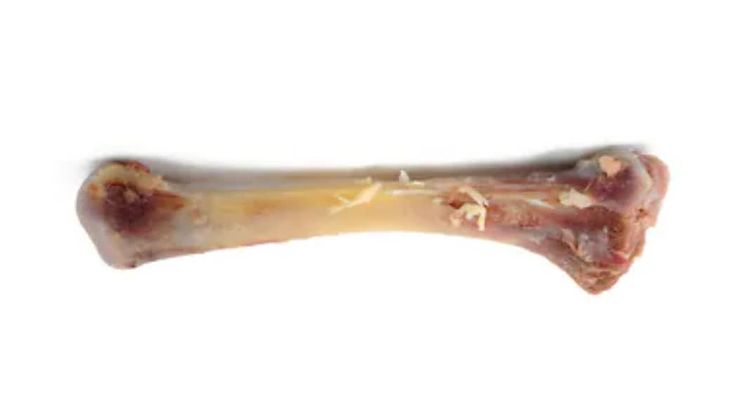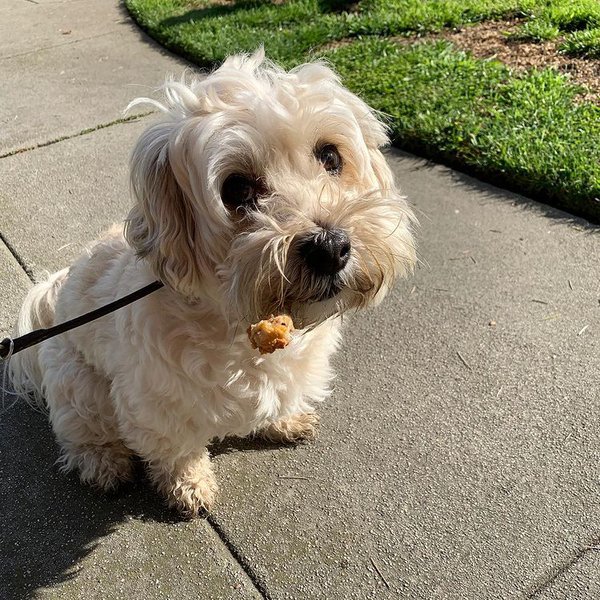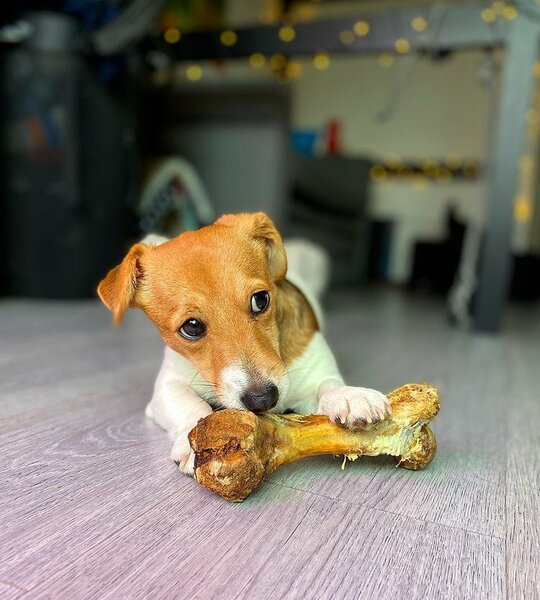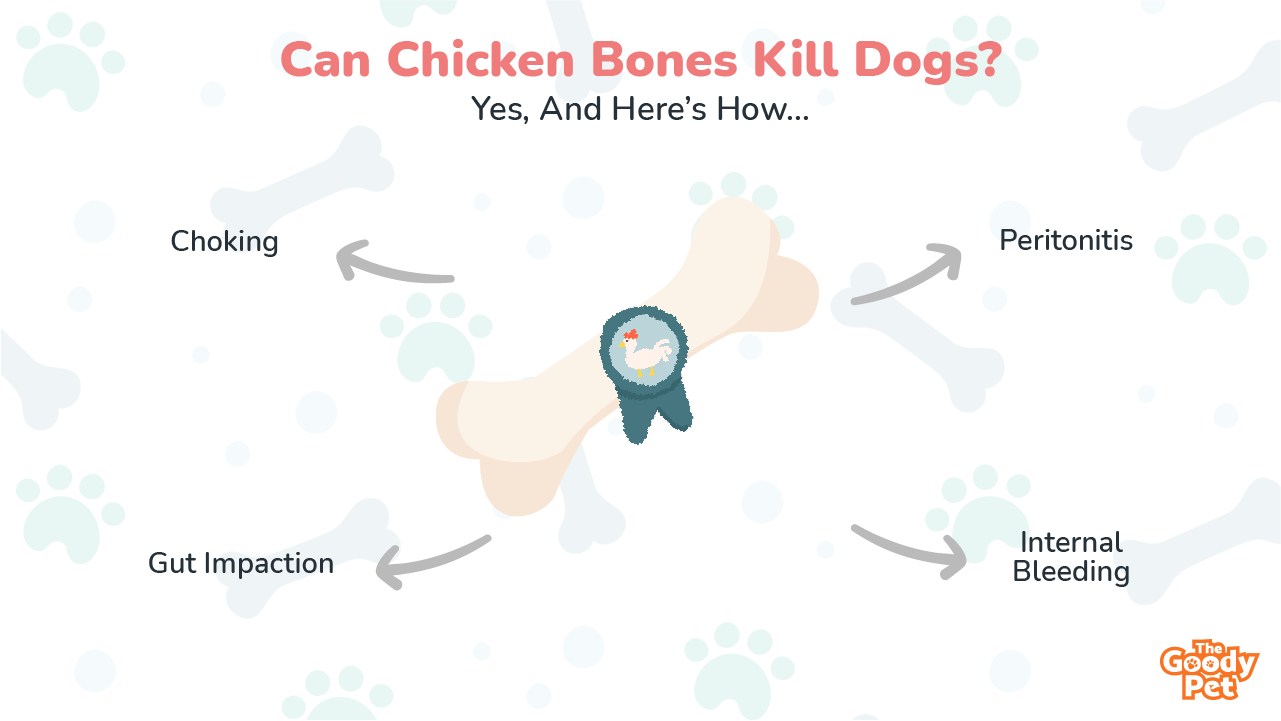Dogs love to chew on bones, and many owners give their dog bones as a treat. However, what happens when your dog accidentally eats a chicken bone?
While chicken bones are not as hard as other bones, they can still splinter and cause serious health problems for your dog, including choking, internal bleeding, or damage to the digestive tract.
Be sure to monitor your dog closely. Look for any signs of discomfort or difficulty breathing. If your dog seems to be in pain or having difficulty swallowing, contact your veterinarian immediately
Can Chicken Bones Kill Dogs?

Before we get to what happens when a dog swallows a bone, let’s find out whether it’s okay to feed your dog with chicken bones.
To begin, bones are a good source of minerals such as phosphorus and calcium that are beneficial to your fido’s health. As such, it’s okay to give chicken bones to dogs.
Ideally, though, dogs are supposed to gnaw on bones, not swallow them.
So, can dogs eat boiled chicken bones?
Cooked bones can be a health hazard to your pet. As a general rule, you should only feed your dog with raw bones, which are less likely to splinter. This is as opposed to cooked bones that are soft, brittle, and easy to splinter into small pieces that can block their digestive system.
Just so you know, dogs can digest both raw and cooked bones. But it’s worth noting that the size of the bone also matters.
Let me explain:
What happens when a dog swallows a bone is that normal digestion takes place. Through grinding contractions as well as the actions of stomach acids, the bone is broken down. However, if the bone is big, full digestion may not take place, making it hard for your dog to poop it out.
Apart from constipation, undigested bones can cause a host of other potentially fatal health problems. Such complications include choking, gut impaction, and peritonitis (abdominal infection from punctured intestines).
As such, there have been over 68 serious cases reported, with the number of dogs dying from eating bones numbering 15.
What Are The Symptoms My Dog Would Show Having Eaten A Chicken Bone?
As earlier noted, it’s best to feed your furry bundle raw bones. So, how long does it take for a dog to digest a raw bone?
Among mammals, dogs have the fastest digestion process, taking around 8 hours from swallowing to passing out waste.
However, large breeds may take a little longer to digest bones, while small breeds can take a shorter time.
If your dog chews on a bone and it splinters, or if it tries to swallow a whole bone, it may end up choking. The first sign of choking is troubled breathing followed by uncontrollable wheezing. Other symptoms include:
- Exaggerated swallowing
- Drooling
- Pacing
- Whining
- Weakness

Splinters from both cooked and raw bones can also tear the intestines and cause internal bleeding. To tell if your fido is bleeding internally, these are the signs and symptoms to look out for:
- Lethargy (weakness)
- Pale gums
- Restlessness
- Troubled breathing
- Distended (swollen) belly
- Vomiting
Note: If left unchecked, internal bleeding can kill a dog in a few hours. Known as hypovolemic shock, severe loss of blood causes decreased oxygen delivery, cell death, organ failure, and eventually, death.
Bowel obstruction is another risk that comes with eating chicken bones. This is the partial or complete blockage inside the stomach, small intestines, or large intestines. As such, it becomes difficult for both solids and fluids to pass along the digestive tract.
The blockage can also cause a build-up of toxins and decreased blood flow, leading to death. So, how do you know if your dog has a bowel obstruction? Indicators include:
- Strenuous bowel movement
- Vomiting and diarrhea
- Stomach pains
- Reduced appetite
Can A Dog’s Stomach Break Down Chicken Bones?

Basically, a dog’s stomach can digest most bone types, including chicken bones. But are these bones fully digested? To understand this, let’s first look at how long it takes a dog to pass a chicken bone.
To begin with, dogs are equipped with strong carnassial teeth that are capable of chewing and grinding chicken bones.
Typically, it takes about 8 to 24 hours for a dog to poop something out after swallowing.
The same goes for chicken bones that have been swallowed whole; once the bone hits the stomach, it dissolves. Your canine buddy will poop something out. If the poop is dry, white, and chalky, then the chicken bones have been processed and passed.
That said, if you don’t spot bone segments passing through within 72 hours after ingestion, then it’s time to visit a vet. This is to make sure that these chicken bones are not stuck in the dog’s intestine, esophagus, or throat.
Within this period, keep an eye on your dog for any signs of ill effects like choking, drooling, or any of the symptoms explained above. These signs are a clear indication of the splinters being stuck in the dog.
It’s also worth noting that out of the many dogs that swallow chicken bones each year, most of them come out of the situation pretty unharmed. As such, it’s clear that a dog’s stomach can break down chicken bones. Even when only partial digestion takes place, there is a high chance that the bone residue will eventually pass out in the poop.
How Can I Help My Dog Pass An Object?

The first thing after noticing that your dog is having difficulty pooping is calling the vet. In your call, ensure that you can describe the symptoms that your dog is exhibiting to help in the diagnosis. The right description can help you not to waste time that would be best spent rushing them to surgery.
With that in mind, here are some methods to help your dog pass an object without harming them.
Feed Your Dog Some Food
If the dog did swallow a heavy object like a stone, feed it a bulky dry meal.
Food not only helps move the object but also turns on the dog’s digestive juices that, in turn, soften wads of hard treats. This allows the obstructing objects to pass more readily.
After feeding the dog, monitor its poop to see if the object gets excreted.
Induce Vomiting
Induce vomiting by feeding your dog with natural food throw-up mixes. As a precaution, don’t induce vomiting if your dog has swallowed a corrosive substance such as an acid because it causes more damage when coming out.
Perform A Heimlich Maneuver
It’s dangerous when an object blocks your dog’s airway to the extent that they lose consciousness.
If that happens, make a fist with your hand on the stomach of your dog and firmly push both up and inward towards the ribcage. Then swipe your finger in the dog’s mouth for any dislodged object.
This is known as the Heimlich maneuver.
What Alternatives Are There To Chicken Bones?
It is no secret that dogs love chicken bones. But as we have seen, bones are prone to splintering, making them dangerous for feeding to dogs.
So, what are the best alternatives to chicken bones?

Dried Fish Skin
Fish skin contains nutritional minerals found, such as the ones found in chicken bones. Additionally, it’s a rich source of omega-3 fatty acids and vitamins B and D. It’s also dog-chewable, and very unlikely to get stuck when swallowed in big chunks.
Raw Meat Bones
Unlike cooked bones, raw bones are strong and meaty. Additionally, they don’t splinter easily. What about nutrients? They are also richer in natural calcium and phosphorus than cooked bones.
Not to take anything away from cooked bones, but due to cooking, some of their nutrients are drained. Raw bones from cows and lambs are safer options as they are large and stronger than chicken bones.
Bone Meals Or MCHA Powder
These products are just powdered bones, similar to actual bones, and contain, to a lesser extent, calcium and phosphorus. You can also purchase ground bones or buy a grinder and do it yourself.
Chicken Feet
Feed your dog either raw or cooked chicken feet. They contain little bone and lots of cartilage. As such, the chances of splintering are close to none.
Raw Green Tripe
Tripe, the lining found in the stomach of ruminating animals, is high in proteins, making it perfect for dogs. It is also high in phosphorus and calcium, as well as digestive enzymes and amino acids. Additionally, tripe is chewable and an excellent standalone meal for your dog, especially when they are recovering from a disease or need to gain weight fast.
Related Questions
Can Dogs Eat Chicken Wings? Though chicken wings are a good source of nutrients for dogs, they contain small and brittle bones. As such, the bones can splinter easily and obstruct your dog’s digestive system. Worse still, the splinters can tear the insides of your pooch, leading to internal bleeding that can lead to death. It is not highly recommended to feed dogs chicken wings.
Can Dogs Eat Chicken Skin? Dogs can and do eat chicken skin, but ideally, they shouldn’t. Chicken skin has excess fat and calories, which have little to no value to a dog. While all meats contain a little fat, feeding on chicken skin can lead to diarrhea, obesity, and stomach upsets. In the long term, the dog may contract pancreatitis.
Can Dogs Have Chicken Broth? Bone-based broths contribute massively to a dog’s health. Specifically, chicken broth is rich in glycine, an amino acid that helps in detoxing your dog’s liver and kidneys. Go for a product like Probiotic Broth Booster, which is formulated to help your furry companion fight stomach constipation, bloating, and gas.





